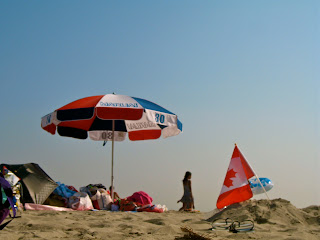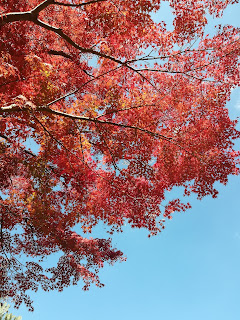English Speaking Society (English club)
Having been placed at two high schools, I inherited the responsibility of managing the ESS (English Speaking Society), or English club. The two schools have very different clubs — my main school's has thirty members, and the other school has only three. It makes for very different experiences in each club. English club is also part of the reason I don't have much of a life outside school; I stay after school ends on both Wednesday and Thursday to run the club, which usually goes for about an hour and a half, or occasionally, two hours.
Despite the challenges of English club, I am really happy with the direction the two clubs are going in. I'll share a few pictures (with members' faces blurred for privacy) so you can get an idea of what I've been doing with them. Unfortunately, one picture I don't have is of my main school's club members on the day of the culture festival, where they put on an original play they wrote themselves, about Disney princesses. It was really cute! They wrote it with the help of my predecessor, and the story was basically about choosing the "one true princess" out of Snow White, Rapunzel, and Elsa/Anna. In the end, there was no true princess because each one was unique. ^_^
At the beginning of my time here, I did a survey with the ESS students, asking them what kinds of things they wanted to do in the club. Naturally, a lot of them answered that they wanted to watch movies and listen to music. I brainstormed my own ideas, too, while they did the survey, and one of my ideas was multicultural lessons. For this club meeting, I chose Ghana, an English-speaking country in West Africa. I gave the students some clues about the country before jumping in, such as that it's a big gold exporter and that people eat cassava (AKA yucca, which I just learned is actually quite toxic if not prepared/processed properly!) and plantains. Then we did a little timeline sorting activity that I adapted from a "day in the life" of a Ghanaian child from TIME for Kids.
After that, I gave them lots of colored paper, makeshift watercolors (the dollar store only had crayons that you paint over with water to make a watercolor effect...) and markers so they could make paper versions of Ghanaian kente cloth. I got the activity from KidWorldCitizen. I highly recommend this craft!
Another day, around Halloween, I decided we should make a pumpkin pie. This was before my friend E sent me canned pumpkin, so I decided we should go with kabocha squash, a native Japanese gourd! I reserved the school home economics room in advance with the help of another English teacher and the home ec teacher, and bought the ingredients myself. We followed this kabocha pie recipe but used real milk and butter, and substituted butter cookies for graham crackers since you can't find graham crackers in the Japanese countryside. It turned out pretty well, and only took about two hours! We had a little sit-down to eat our pieces, then gave the rest to some teachers, including the home ec and English teachers who had helped orchestrate the kitchen usage. I replicated the pie at home using the leftover squash (I had bought too much) but it was a little too chunky...
One of my official, formal goals for this year, which I had to write at the beginning of my time here, was to maintain and publish an ESS newsletter two times in the school year. After a few setbacks — cultural festival taking priority, Halloween parties, testing periods during which no club meetings were held — we finally got the ball rolling on a winter newsletter. The students put the above newsletter together over two meetings, and next week, we'll hand it out to the teachers and put copies on the bulletin board of each grade's floor. I am pretty proud of what they accomplished, although I will say I am a little annoyed that the student gluing the bottom sections didn't line up the curves of the snowman with the middle ones. Oh well! Overall it was a success, and I hope students will stop in the hallways to read the ones we put on the bulletin boards.
A couple weeks ago, the second year students were gone on a school trip to Tokyo and Hokkaido. Since the third years had already left the club in order to focus on their college entrance exams, it was only the first years at ESS that week. I decided to do a multicultural lesson like the Ghana one (though this time the lesson was at my main school, which hadn't had a chance to do the Ghana lesson). So I picked India. We started by drawing maps of Japan and talking about Japanese dialects, which got a lively discussion going. Then we listed countries that speak different varieties of English, which was a challenge for them. (Some answers: Mongolia, China, Finland — though to be fair the Scandinavians are good at English.)
After that I gave them some hints about the country I chose, plus two red herrings. They had to guess the country, which was India, and figure out which clues the red herring were (I picked a panda from China and a gamelan from Indonesia; the gamelan was hard for them to guess because it looks as if it could be Indian). Then we read through a choose-your-own-adventure story about Indian culture that I wrote in (kind of) simplified English and created in PowerPoint. After that, we played a checkers-like game that originated in India, called Goats and Tigers. I printed the board and rules from Traditional Games India and used some flat marbles from the dollar store as pieces. It was a lot of fun, and we played as two teams.
I hope this gives other JETs some interesting ideas for things they can do in English club. I've really had a good time with these clubs and their members (almost all girls!). Hope I can sustain the momentum through the new year!
Despite the challenges of English club, I am really happy with the direction the two clubs are going in. I'll share a few pictures (with members' faces blurred for privacy) so you can get an idea of what I've been doing with them. Unfortunately, one picture I don't have is of my main school's club members on the day of the culture festival, where they put on an original play they wrote themselves, about Disney princesses. It was really cute! They wrote it with the help of my predecessor, and the story was basically about choosing the "one true princess" out of Snow White, Rapunzel, and Elsa/Anna. In the end, there was no true princess because each one was unique. ^_^
At the beginning of my time here, I did a survey with the ESS students, asking them what kinds of things they wanted to do in the club. Naturally, a lot of them answered that they wanted to watch movies and listen to music. I brainstormed my own ideas, too, while they did the survey, and one of my ideas was multicultural lessons. For this club meeting, I chose Ghana, an English-speaking country in West Africa. I gave the students some clues about the country before jumping in, such as that it's a big gold exporter and that people eat cassava (AKA yucca, which I just learned is actually quite toxic if not prepared/processed properly!) and plantains. Then we did a little timeline sorting activity that I adapted from a "day in the life" of a Ghanaian child from TIME for Kids.
 |
| My (paper) kente cloth! |
Another day, around Halloween, I decided we should make a pumpkin pie. This was before my friend E sent me canned pumpkin, so I decided we should go with kabocha squash, a native Japanese gourd! I reserved the school home economics room in advance with the help of another English teacher and the home ec teacher, and bought the ingredients myself. We followed this kabocha pie recipe but used real milk and butter, and substituted butter cookies for graham crackers since you can't find graham crackers in the Japanese countryside. It turned out pretty well, and only took about two hours! We had a little sit-down to eat our pieces, then gave the rest to some teachers, including the home ec and English teachers who had helped orchestrate the kitchen usage. I replicated the pie at home using the leftover squash (I had bought too much) but it was a little too chunky...
One of my official, formal goals for this year, which I had to write at the beginning of my time here, was to maintain and publish an ESS newsletter two times in the school year. After a few setbacks — cultural festival taking priority, Halloween parties, testing periods during which no club meetings were held — we finally got the ball rolling on a winter newsletter. The students put the above newsletter together over two meetings, and next week, we'll hand it out to the teachers and put copies on the bulletin board of each grade's floor. I am pretty proud of what they accomplished, although I will say I am a little annoyed that the student gluing the bottom sections didn't line up the curves of the snowman with the middle ones. Oh well! Overall it was a success, and I hope students will stop in the hallways to read the ones we put on the bulletin boards.
A couple weeks ago, the second year students were gone on a school trip to Tokyo and Hokkaido. Since the third years had already left the club in order to focus on their college entrance exams, it was only the first years at ESS that week. I decided to do a multicultural lesson like the Ghana one (though this time the lesson was at my main school, which hadn't had a chance to do the Ghana lesson). So I picked India. We started by drawing maps of Japan and talking about Japanese dialects, which got a lively discussion going. Then we listed countries that speak different varieties of English, which was a challenge for them. (Some answers: Mongolia, China, Finland — though to be fair the Scandinavians are good at English.)
After that I gave them some hints about the country I chose, plus two red herrings. They had to guess the country, which was India, and figure out which clues the red herring were (I picked a panda from China and a gamelan from Indonesia; the gamelan was hard for them to guess because it looks as if it could be Indian). Then we read through a choose-your-own-adventure story about Indian culture that I wrote in (kind of) simplified English and created in PowerPoint. After that, we played a checkers-like game that originated in India, called Goats and Tigers. I printed the board and rules from Traditional Games India and used some flat marbles from the dollar store as pieces. It was a lot of fun, and we played as two teams.
I hope this gives other JETs some interesting ideas for things they can do in English club. I've really had a good time with these clubs and their members (almost all girls!). Hope I can sustain the momentum through the new year!






Comments
Post a Comment